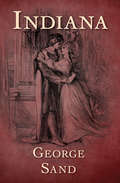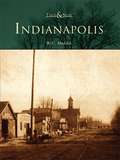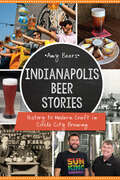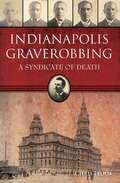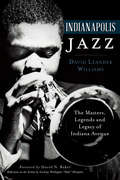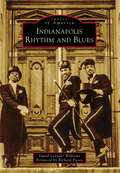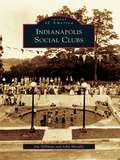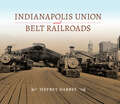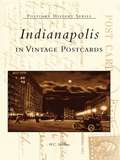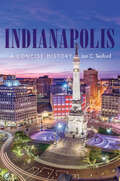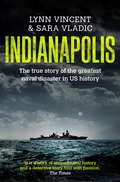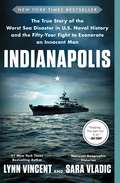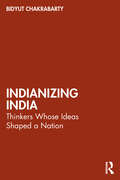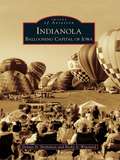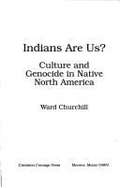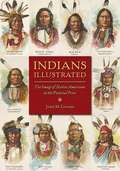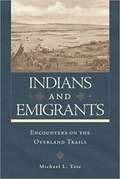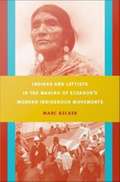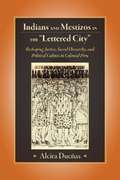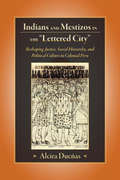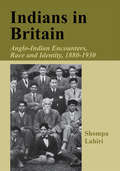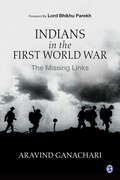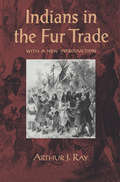- Table View
- List View
Indiana: A Love Story (Erotic Classics )
by George SandA noblewoman travels from colonial Africa to revolutionary France in search of love in this nineteenth-century romantic classic. On the Île Bourbon off the coast of Madagascar, Indiana is miserable in her marriage to the cold Colonel Delmare. Although she has a friendly companion in the ever-present Englishman Sir Ralph, she yearns to feel passion and desire. When she catches the interest of the handsome young Raymon de Ramiere, Indiana is willing to take any risk, including running away to France as the July Revolution rages in Paris. But after she falls ill, she will begin a transformation that could bring about her happiness—or her downfall. The first novel Amantine Aurore Dupin published under the pseudonym George Sand, Indiana was an auspicious debut from one of the most fascinating and daring women of the early nineteenth century, a rebellious artist who defied societal expectations and went on to become one of the major names in French literature.
Indianapolis
by W. C. MaddenInaugurated as the state capital in 1825, Indianapolis was patterned after the nation's capital and laid out on a mile-square grid with Monument Circle at its center. As the city grew and experienced the tumult of the Civil War, legislators decided to erect a monument to the war's fallen servicemen. In 1902, one of the world's most outstanding memorials was completed-the Soldiers and Sailors Monument. Surrounding Monument Circle, "The Circle City" gets its nickname from the prominence and historical significance of the central city structure. Throughout the years, Indianapolis has maintained its commitment to honoring the achievements of Hoosiers. This dedication to Indiana has given the capital its own rich history, told not only through monuments and memorials, but also through the architecture, parks, businesses, and people that make up the heart of Indianapolis. This new book documents the heroes and history of the city, using an impressive collection of vintage photographs from the late 1800s through the early 1900s juxtaposed against present-day images.
Indianapolis Beer Stories: History to Modern Craft in Circle City Brewing (American Palate)
by Amy BeersIndianapolis Beer Stories is a time capsule of tales from the city's early taverns, to a pre-Prohibition golden era, to today's modern craft beer scene.Meet the ghosts of Indy's brewing past. Discover the very beginning of beer in Indiana's new capital and the pioneers who carved a path for a future industry. Uncover the legacy of a bygone brewing giant. Learn how one spontaneous decision to cross the treacherous Rocky Mountains led to a booming craft beer scene in Indiana.Indiana native Amy Beers, a Certified Cicerone® and owner/operator of Drinking with Beers, leads a heady tour of yesterday and today in Circle City brewing.
Indianapolis Graverobbing: A Syndicate of Death (True Crime)
by Chris FlookSurveying the sensational newspaper accounts as events unfolded, author and historian Chris Flook recounts this grisly tale of political intrigue and conspiracy. In the fall of 1902, Indianapolis police uncovered a prolific graverobbing ring operating across the city. At the time, cemeteries across central Indiana were relieved of their dead by ghouls, as they were called, seeking fresh corpses desperately needed by the city's medical colleges. The ring was also accused of multiple murders. In Hamilton County, a former Confederate soldier named Wade West delivered stolen corpses by floating them down the White River. His counterpart in Indianapolis, Rufus Cantrell, an itinerant preacher and full-time graverobber known as the "King of the Ghouls," ransacked Indy's cemeteries for years before being caught.
Indianapolis Jazz: The Masters, Legends and Legacy of Indiana Avenue (Music Ser.)
by David N. Baker David Leander WilliamsGet into the music with David Leander Williams as he charts the rise and fall of Indiana Avenue, the Majestic Entertainment Boulevard of Indianapolis, which produced some of the nation's most influential jazz artists. The performance venues that once lined the vibrant thoroughfare were an important stop on the Chitlin' Circuit and provided platforms for greats like Freddie Hubbard and Jimmy Coe. Through this biography of the bustling street, meet scores of the other musicians who came to prominence in the avenue's heyday, including trombonist J.J. Johnson and guitarist Wes Montgomery, as well as songwriters like Noble Sissle and Leroy Carr.
Indianapolis Rhythm and Blues (Images of America)
by David Leander WilliamsIndiana Avenue was traditionally the host to some of America's premier, world-renown entertainment icons in various genres. Along this winding, brightly lit thoroughfare were nightclubs, lounges, supper clubs, taverns, juke joints, and holes-in-the-wall that celebrated the best of the best in entertainment that America had to offer, from the 1920s on into the 1970s. On the bandstand at Denver Ferguson's Sunset Terrace Ballroom, the elegantly attired crooner Nat King Cole, in a sparkling blue silk suit, delivered his signature song "Mona Lisa." Nearby, B.B. King sang his 1973 down-home blues classic "To Know You is to Love You." At Tuffy Mitchell's Pink Poodle nightclub, "Moms" Mabley made the audience roar with laughter during her sidesplitting comedy routine. Indiana Avenue truly was the place to be for the best in entertainment.
Indianapolis Social Clubs (Images of America)
by John Murphy Jim HillmanMore than banquet halls, golf courses, and swimming pools, social clubs were a haven for businessmen, politicians, and community leaders, offering respite from public scrutiny. Defining Indianapolis, the clubs were stoic agents of power and segregation, providing clear historical snapshots of Hoosier pomp and circumstance. The clubs did more than produce Olympic swimmers, world-class golfers, and tennis professionals; they were Indianapolis's multigenerational playgrounds. There were the politics and business dealings at the Columbia Club and the Indianapolis Athletic Club, the golfing, tennis, and formality of Woodstock, Meridian Hills, and other country clubs, and the family fun in the sun at Riviera, Devon, and Olympia. These organizations offered more than magical summers with family and friends; they were the places to be seen.
Indianapolis Union and Belt Railroads (Railroads Past and Present)
by Jeffrey DarbeeA comprehensive history of how railroads aided in the growth of Indiana and its capital city, featuring maps and illustrations.In an era dominated by huge railroad corporations, Indianapolis Union and Belt Railroads reveals the important role two small railroad companies had on development and progress in the Hoosier State. After Indianapolis was founded in 1821, early settlers struggled to move people and goods to and from the city, with no water transport nearby and inadequate road systems around the state. But in 1847, the Madison & Indianapolis Railroad connected the new capital city to the Ohio River and kicked off a railroad and transportation boom. Over the next seven decades, the Indiana railroad map expanded in all directions, and Indianapolis became a rail transport hub, dubbing itself the “Railroad City.” Though the Pennsylvania and the New York Central Railroads traditionally dominated the Midwest and Northeast and operated the majority of rail routes radiating from Indianapolis, these companies could not have succeeded without the two small railroads that connected them.In the downtown area, the Indianapolis Union Railway was less than two miles long, and out at the edge of town the Belt Railroad was only a little over fourteen miles. Though small in size, the Union and the Belt had an outsized impact, both on the city’s rail network and on the city itself. It played an important role both in maximizing the efficiency and value of the city’s railroad freight and passenger services and in helping to shape the urban form of Indianapolis in ways that remain visible today.“A good history book explains why things are the way they are. This is a great history book, neatly telling the value of railroads in the development of the United States as well as in Indianapolis. Footnotes and bibliography combined with maps and ephemera and photos of everything from track construction to buildings to locomotives make it of interest to architects and engineers as well as rail fans and Hoosier history buffs. It’s a super tour guide, too.” —Cynthia L. Ogorek, coauthor of The Chicago & Western Indiana Railroad“An interesting history not only of these two railroads but how they ultimately served as a model for the many other belt railroads . . . [The book discusses] how and why railroads transformed Indianapolis into a major city; in fact, the largest U.S. city not on navigable water.” —Tom Hoback, Owner, Indiana Rail Road Company
Indianapolis in Vintage Postcards (Postcard History)
by W. C. MaddenIn the late 1800s, postcards of Indianapolis began appearing in mailboxes throughout the country. Since that time, the many prominent monuments, buildings, and parks of the Hoosier capital have been featured on countless cards.Using an impressive collection of these images, author W.C. Madden takes the reader on an historic journey through Indianapolis from 1890 to 1950, providing a visual history of the development of the city. Indianapolis experienced great growth during the first half of the 20th century, which gave rise to innovative art and architectural structures, many that serve as the subject of postcards featured here. The Soldiers and Sailors Monument, the Indiana World War Memorial, the Indianapolis Motor Speedway, Union Station, and Claypool Hotel, to name a few, are all highlighted.
Indianapolis: A Concise History (Heartland History)
by Jon C. TeafordAs its name denotes, Indianapolis is without question Indiana's city. Known as the Crossroads of America, Indianapolis and the surrounding communities have and continue to play an important role in politics, logistics, and commerce for both the state and the country.Indianapolis: A Concise History looks at the development of the city from a frontier village to a major railroad city in the late nineteenth century and through its continued growth in the twentieth century. Author and historian Jon C. Teaford reveals the origins of the Indianapolis Speedway, the rise and fall of the Ku Klux Klan, the persistent racial tension in the city, and the revitalization efforts under Mayor William Hudnut and his successors. Since 1824 Indianapolis has been the state's largest city, its political center, and the home of Indiana's state government, and it continues to be a center for urban growth.
Indianapolis: The True Story Of The Worst Sea Disaster In U. S. Naval History And The Fifty-year Fight To Exonerate An Innocent Man
by Lynn Vincent“This is an absorbing book. The attention to detail is superb, the clear result of lots of plain hard work. Yet the detail doesn’t get in the way, but rather serves, along with a driving narrative, to get the reader as close to experiencing this most tragic episode of World War II as is possible without living through it. The book is hard to put down.”— Karl Marlantes, New York Times bestselling author of MatterhornThe sinking of the USS Indianapolis is still the biggest single loss of life at sea to be suffered by the United States navy. From a crew of 1,196 men, only 317 survived. Torpedoed by the Japanese, dying of thirst and eaten by sharks. For 70 years, the story of the USS Indianapolis has been told as a sinking story, or a shark story, or a story of military justice gone awry. But in Indianapolis, the true story of this mighty vessel is revealed. As the USS Arizona embodies the beginning of the Pacific war, the USS Indianapolis embodies its fiery end. From its bridge, Admiral Raymond Spruance devised and executed the island-hopping campaign that decimated Japan’s Navy and Army. Its crew led the fleet from Pearl Harbour to the islands of Japan, notching an unbroken string of victories in an exotic and uncharted theatre of war. When the time came for President Harry S. Truman to deal Japan the decisive blow, Indianapolis answered the call. And super-spy Major Robert S. Furman climbed aboard, secreting the components of the world’s first atomic bomb. Four days after delivering her ominous cargo to the island of Tinian, the Indianapolis was sunk by a Japanese submarine, with nearly 900 men lost. The captain, Charles B. McVay III, was wrongly court-martialled for negligence over the sinking. Decades after these events, the survivors of the Indianapolis, as well as the Japanese submarine commander who sank it, joined together to finally exonerate McVay. “The voices of the Greatest Generation come alive in Indianapolis. Through first-person accounts we hear horrific stories of fear, pain, and anger but also of resilience, hope, and courage. Stories of the friendships the sailors forged with each other on board and the sacrifices they made for each other in their darkest hours are inspirational. Ultimately, Indianapolis is about the sacrifice these men made for our country at a time of unparalleled risk and of their lifelong search for justice for the captain of their ship. It’s a beautifully told and incredibly detailed narrative that brings this famous disaster to life.”— Kate Andersen Brower, #1 New York Times bestselling author of The Residence and First Women
Indianapolis: The True Story of the Worst Sea Disaster in U.S. Naval History and the Fifty-Year Fight to Exonerate an Innocent Man
by Lynn Vincent Sara Vladic<P><P>Just after midnight on July 30, 1945, days after delivering the components of the atomic bomb from California to the Pacific Islands in the most highly classified naval mission of the war, USS Indianapolis is sailing alone in the center of the Philippine Sea when she is struck by two Japanese torpedoes. The ship is instantly transformed into a fiery cauldron and sinks within minutes. <P><P>Some 300 men go down with the ship. Nearly 900 make it into the water alive. For the next five nights and four days, almost three hundred miles from the nearest land, the men battle injuries, sharks, dehydration, insanity, and eventually each other. Only 316 will survive. For the better part of a century, the story of USS Indianapolis has been understood as a sinking tale. <P><P>The reality, however, is far more complicated—and compelling. Now, for the first time, thanks to a decade of original research and interviews with 107 survivors and eyewitnesses, Lynn Vincent and Sara Vladic tell the complete story of the ship, her crew, and their final mission to save one of their own. It begins in 1932, when Indianapolis is christened and launched as the ship of state for President Franklin Roosevelt. After Pearl Harbor, Indianapolis leads the charge to the Pacific Islands, notching an unbroken string of victories in an uncharted theater of war. <P><P>Then, under orders from President Harry Truman, the ship takes aboard a superspy and embarks on her final world-changing mission: delivering the core of the atomic bomb to the Pacific for the strike on Hiroshima. <P><P>Vincent and Vladic provide a visceral, moment-by-moment account of the disaster that unfolds days later after the Japanese torpedo attack, from the chaos on board the sinking ship to the first moments of shock as the crew plunge into the remote waters of the Philippine Sea, to the long days and nights during which terror and hunger morph into delusion and desperation, and the men must band together to survive. <P><P>Then, for the first time, the authors go beyond the men’s rescue to chronicle Indianapolis’s extraordinary final mission: the survivors’ fifty-year fight for justice on behalf of their skipper, Captain Charles McVay III, who is wrongly court-martialed for the sinking. <P><P>What follows is a captivating courtroom drama that weaves through generations of American presidents, from Harry Truman to George W. Bush, and forever entwines the lives of three captains—McVay, whose life and career are never the same after the scandal; Mochitsura Hashimoto, the Japanese sub commander who sinks Indianapolis but later joins the battle to exonerate McVay; and William Toti, the captain of the modern-day submarine Indianapolis, who helps the survivors fight to vindicate their captain. <P><P> A sweeping saga of survival, sacrifice, justice, and love, Indianapolis stands as both groundbreaking naval history and spellbinding narrative—and brings the ship and her heroic crew back to full, vivid, unforgettable life. It is the definitive account of one of the most remarkable episodes in American history. <P><b>A New York Times Bestseller</b>
Indianizing India: Thinkers Whose Ideas Shaped a Nation
by Bidyut ChakrabartyThis book presents a comprehensive portrait of how Indians conceived of the idea of India. It highlights the diverse traditions and intellectual threads that contributed to the making of vibrant democracy.The book:• Examines the different ideas of India through 14 eminent Indian thinkers: Mahatma Gandhi, Rabindranath Tagore, Dayanand Saraswati, VD Savarkar, Savitribai Phule, Pandita Ramabai, Maulana Azad, Jawaharlal Nehru, BR Ambedkar, Subhash Chandra Bose, Aurobindo Ghosh, Sarala Devi Chaudhurani and MA Jinnah;• Highlights how ancient and modern intellectual discourses coalesced with the aspirations of ordinary Indians under the yoke of colonialism;• Challenges colonial constructs and linear approaches to studying India.Accessibly written, this book is essential reading for students and researchers of Indian political thought, modern history, political science, and South Asian studies.
Indianola: Ballooning Capital of Iowa (Images of Aviation)
by Dennis D. Nicholson Becky S. WigelandIndianola, founded in 1849, is the county seat of Warren County, Iowa. It is located 12 miles south of Iowa's capital, Des Moines, at the intersection of U.S. highways 65 and 69 and state highway 92. The city is home of the National Balloon Museum, begun in 1972; the National Balloon Classic, an annual nine-day balloon rally; the Balloon Federation of America's national office; Simpson College; the Des Moines Metro Opera, a widely acclaimed summer opera festival; and is host to the Iowa Wine Festival each summer. This book focuses on the history of ballooning in Indianola, which hosted the U.S. National Hot Air Balloon Championships from 1970 to 1988, and the National Balloon Classic from 1989 to the present. This is the story of how Indianola became the ballooning capital of Iowa.
Indians Are Us?: Culture and Genocide in Native North America
by Ward ChurchillChurchill sets out to expose those who would appropriate native culture and turn it into a commodity to be bought and sold. He reviews books and movies which have historical inaccuracies and which perpetuate stereotypes. Other essays deal with the issue of products and sports teams and the impact of government definitions of who is and is not Indian.
Indians Illustrated: The Image of Native Americans in the Pictorial Press
by John M CowardAfter 1850, Americans swarmed to take in a raft of new illustrated journals and papers. Engravings and drawings of "buckskinned braves" and "Indian princesses" proved an immensely popular attraction for consumers of publications like Frank Leslie's Illustrated Newspaper and Harper's Weekly . In Indians Illustrated , John M. Coward charts a social and cultural history of Native American illustrations--romantic, violent, racist, peaceful, and otherwise--in the heyday of the American pictorial press. These woodblock engravings and ink drawings placed Native Americans into categories that drew from venerable "good" Indian and "bad" Indian stereotypes already threaded through the culture. Coward's examples show how the genre cemented white ideas about how Indians should look and behave--ideas that diminished Native Americans' cultural values and political influence. His powerful analysis of themes and visual tropes unlocks the racial codes and visual cues that whites used to represent--and marginalize--native cultures already engaged in a twilight struggle against inexorable westward expansion.
Indians and Emigrants: Encounters on the Overland Trails
by Michael L. TateIn the first book to focus on relations between Indians and emigrants on the overland trails, Michael L. Tate shows that such encounters were far more often characterized by cooperation than by conflict. Having combed hundreds of unpublished sources and Indian oral traditions, Tate finds Indians and Anglo-Americans continuously trading goods and news with each other, and Indians providing various forms of assistance to overlanders. <P><P> Tate admits that both sides normally followed their own best interests and ethical standards, which sometimes created distrust. But many acts of kindness by emigrants and by Indians can be attributed to simple human compassion. <P><P> Not until the mid-1850s did Plains tribes begin to see their independence and cultural traditions threatened by the flood of white travelers. As buffalo herds dwindled and more Indians died from diseases brought by emigrants, violent clashes between wagon trains and Indians became more frequent, and the first Anglo-Indian wars erupted on the plains. Yet, even in the 1860s, Tate finds, friendly encounters were still the rule. <P><P> Despite thousands of mutually beneficial exchanges between whites and Indians between 1840 and 1870, the image of Plains Indians as the overland pioneers’ worst enemies prevailed in American popular culture. In explaining the persistence of that stereotype, Tate seeks to dispel one of the West’s oldest cultural misunderstandings.
Indians and Leftists in the Making of Ecuador's Modern Indigenous Movements
by Marc BeckerIn June 1990, Indigenous peoples shocked Ecuadorian elites with a powerful uprising that paralyzed the country for a week. Militants insisted that the government address Indigenous demands for land ownership, education, and economic development. This uprising was a milestone in the history of Ecuador's social justice movements, and it inspired popular organizing efforts across Latin America. While the insurrection seemed to come out of nowhere, Marc Becker demonstrates that it emerged out of years of organizing and developing strategies to advance Indigenous rights. In this richly documented account, he chronicles a long history of Indigenous political activism in Ecuador, from the creation of the first local agricultural syndicates in the 1920s through the galvanizing protests of 1990. In so doing, he reveals the central role of women in Indigenous movements and the history of productive collaborations between rural Indigenous activists and urban leftist intellectuals. Becker explains how rural laborers and urban activists worked together in Ecuador, merging ethnic and class-based struggles for social justice. Socialists were often the first to defend Indigenous languages, cultures, and social organizations. They introduced rural activists to new tactics, including demonstrations and strikes. Drawing on leftist influences, Indigenous peoples became adept at reacting to immediate, local forms of exploitation while at the same time addressing broader underlying structural inequities. Through an examination of strike activity in the 1930s, the establishment of a national-level Ecuadorian Federation of Indians in 1944, and agitation for agrarian reform in the 1960s, Becker shows that the history of Indigenous mobilizations in Ecuador is longer and deeper than many contemporary observers have recognized.
Indians and Mestizos in the "Lettered City"
by Alcira DuenasThrough newly unearthed texts virtually unknown in Andean studies, Indians and Mestizos in the "Lettered City" highlights the Andean intellectual tradition of writing in their long-term struggle for social empowerment and questions the previous understanding of the "lettered city" as a privileged space populated solely by colonial elites. Rarely acknowledged in studies of resistance to colonial rule, these writings challenged colonial hierarchies and ethnic discrimination in attempts to redefine the Andean role in colonial society. Scholars have long assumed that Spanish rule remained largely undisputed in Peru between the 1570s and 1780s, but educated elite Indians and mestizos challenged the legitimacy of Spanish rule, criticized colonial injustice and exclusion, and articulated the ideas that would later be embraced in the Great Rebellion in 1781. Their movement extended across the Atlantic as the scholars visited the seat of the Spanish empire to negotiate with the king and his advisors for social reform, lobbied diverse networks of supporters in Madrid and Peru, and struggled for admission to religious orders, schools and universities, and positions in ecclesiastic and civil administration. Indians and Mestizos in the "Lettered City" explores how scholars contributed to social change and transformation of colonial culture through legal, cultural, and political activism, and how, ultimately, their significant colonial critiques and campaigns redefined colonial public life and discourse. It will be of interest to scholars and students of colonial history, colonial literature, Hispanic studies, and Latin American studies.
Indians and Mestizos in the "Lettered City": Reshaping Justice, Social Hierarchy, and Political Culture in Colonial Peru
by Alcira Duenas Alcira DueñasThrough newly unearthed texts virtually unknown in Andean studies, Indians and Mestizos in the "Lettered City" highlights the Andean intellectual tradition of writing in their long-term struggle for social empowerment and questions the previous understanding of the "lettered city" as a privileged space populated solely by colonial elites. Rarely acknowledged in studies of resistance to colonial rule, these writings challenged colonial hierarchies and ethnic discrimination in attempts to redefine the Andean role in colonial society. Scholars have long assumed that Spanish rule remained largely undisputed in Peru between the 1570s and 1780s, but educated elite Indians and mestizos challenged the legitimacy of Spanish rule, criticized colonial injustice and exclusion, and articulated the ideas that would later be embraced in the Great Rebellion in 1781. Their movement extended across the Atlantic as the scholars visited the seat of the Spanish empire to negotiate with the king and his advisors for social reform, lobbied diverse networks of supporters in Madrid and Peru, and struggled for admission to religious orders, schools and universities, and positions in ecclesiastic and civil administration. Indians and Mestizos in the "Lettered City" explores how scholars contributed to social change and transformation of colonial culture through legal, cultural, and political activism, and how, ultimately, their significant colonial critiques and campaigns redefined colonial public life and discourse. It will be of interest to scholars and students of colonial history, colonial literature, Hispanic studies, and Latin American studies.
Indians in Britain: Anglo-Indian Encounters, Race and Identity, 1880-1930
by Shompa LahiriThis is an analysis of the nature and impact of the Indian presence in Britain, and British reactions to it. Problems of discrimination, isolation, and deprivation turned many students to politics, they appropriated ideas and institutions, and challenged British metropolitan society.
Indians in Kenya
by Sana AiyarSana Aiyar chronicles the strategies by which Indians sought a political voice in Kenya, from the beginning of colonial rule to independence. She examines how the strands of Indians' diasporic identity influenced Kenya's leadership--from partnering with Europeans to colonize East Africa, to collaborating with Africans to battle racial inequality.
Indians in the Family: Adoption and the Politics of Antebellum Expansion
by Dawn PetersonThrough stories of a dozen white adopters, adopted Indian children, and their Native parents in early America, Dawn Peterson shows the role adoption and assimilation played in efforts to subdue Native peoples. As adults, adoptees used their education to thwart U.S. claims to their homelands, setting the stage for the Indian Removal Act of 1830.
Indians in the First World War: The Missing Links
by Aravind GanachariIndians in the First World War: The Missing Links is the first authoritative and complete academic account of the Indian participation in the First World War to be written by an Indian historian. The Great War involved significant Indian military contributions and casualties that are largely unheard of. The war also brought about major changes in the Indian social and political situation, caste structure and viewpoint regarding Indian identity, and fuelled the demand for India’s independence. This book carefully articulates and examines these crucial historic changes. The book covers Indian perspectives on all major aspects—historical, social, political and religious, among others—that were instrumental in ensuring India’s participation in the war. Based on the author’s own research and deep familiarity with Indian history and contemporary political reality, the book throws new light on some major events during the war. It is an indispensable book that deserves to be read by anyone who is interested in gaining a more thorough understanding of India’s contribution to and standing in world history and politics.
Indians in the Fur Trade
by Arthur RayFirst published in 1974, this best-selling book was lauded by Choice as 'an important, ground-breaking study of the Assiniboine and western Cree Indians who inhabited southern Manitoba and Saskatchewan' and 'essential reading for anyone interested in the history of the Canadian west before 1870.' Indians in the Fur Trade makes extensive use of previously unpublished Hudson's Bay Company archival materials and other available data to reconstruct the cultural geography of the West at the time of early contact, illustrating many of the rapid cultural transformations with maps and diagrams. Now with a new introduction and an update on sources, it will continue to be of great use to students and scholars of Native and Canadian history.
